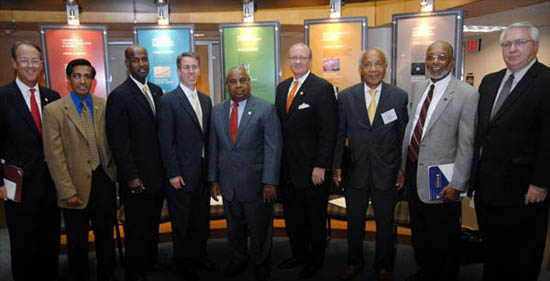A&T Awarded Grant
September 5, 2008
AGGIE NEWS: North Carolina A&T State University has been awarded a grant for an Engineering Research Center (ERC) from the National Science Foundation (NSF). Engineering Research Center grants are among the most prestigious NSF awards, and they represent major investments by NSF in partnership with industry to transform engineering research and education. The centers aim to produce innovative technologies and engineering graduates to significantly enhance the competitiveness of the U.S. economy.  The ERC program has made 49 awards since its initiation in 1985 and is making five new awards in 2008. The award to A&T marks the first time that an HBCU has been the lead institution of an ERC. Award funding has been approved at $18 million for the initial five years, with a potential duration of 10 years.
The ERC program has made 49 awards since its initiation in 1985 and is making five new awards in 2008. The award to A&T marks the first time that an HBCU has been the lead institution of an ERC. Award funding has been approved at $18 million for the initial five years, with a potential duration of 10 years.
The NSF ERC for Revolutionizing Metallic Biomaterials at A&T will conduct research in the areas of biomedical engineering and nano-bio applications and is in partnership with the Universities of Cincinnati and Pittsburgh. It also has a global technical partner in Germanyýs Hannover School of Medicine and a global cultural and outreach partner in the Indian Institute of Technology, Madras, India. California State University at Los Angeles will serve as an outreach partner in the USA. The ERC has partnerships with pre-college institutions in North Carolina to involve teachers and students in engineering; it has partnerships with a broad range of North Carolina organizations devoted to entrepreneurship and small business development.
A&T's ERC will be led by Dr. Jagannathan Sankar, professor of engineering. Dr. William Wagner from the University of Pittsburgh and Dr. Mark Schulz from the University of Cincinnati will serve as co-directors. Dr. Devdas Pai, professor of engineering at A&T, will lead educational aspects of the ERC. The ERC research will focus on three engineered systems: Craniofacial and Orthopedic Applications; Cardiovascular Devices; and Responsive Biosensors for Implants.
The research done in the ERC will introduce devices made with magnesium alloys that have the ability to adapt to the body and "grow" without refitting. After their work is done, the magnesium alloys can be absorbed into the body's bloodstream with no side effects. These implants are expected to have a broad-based impact on craniofacial and orthopedic treatments and may aid children who are born with birth defects and injured veterans and others who have significant bone damage. The ERC will introduce new metallic materials, devices, and systems that have the potential to exhibit all the necessary attributes of an ideal foundation or "scaffold" and that promise to completely transform the field of regenerative medicine. Similarly, innovative metallic materials will be introduced as stents in the treatment of cardiovascular problems. Nano sensors will be developed to study the efficacy of these devices as part of this research. More than eight companies will be associated with the ERC to provide input for the direction of research as well as a conduit to transfer the technology to the real world. NC A&T will also start a new department of bioengineering in conjunction with this ERC. The department will offer BS, Masters and PhD degrees in bioengineering. Both the University of Pittsburgh and the University of Cincinnati will collaborate with A&T in offering these degrees.

The third-generation (Gen-3) Engineering Research Centers build on the successes of the first and second generations of ERCs funded since 1985. The A&T ERC is one of five new Gen-3 ERCs that are designed to create university and industry partnerships in research and education that promote innovation, transform engineered systems, advance technology, and produce engineering graduates who can creatively contribute to U.S. competitive advantage in a global economy. "NSF is delighted to welcome A&T to the ERC program as lead institution," said Lynn Preston, a deputy division director at NSF and leader of the Engineering Research Centers Program. "The unique vision of this ERC to carry out research on new implant technologies for controlled use of degradable metallic implants offers significant opportunities for regenerative medicine for children and adults." Preston expects that the partnerships designed into this ERC will produce important exchanges of knowledge and capabilities among the ERC partner universities in the U.S. and abroad, and that they will significantly enhance our ability to advance this technology and develop graduates who can become leaders in innovation in the global marketplace. "This ERC's educational programs will significantly impact the diversity of the engineering workforce because of its location at A&T and its synergistic partnership with the new A&T department of bioengineering," Preston added. "We look forward to the pre-college partnerships in this ERC attracting a broadly diverse group of students to engineering and medicine."
For additional information, contact Shena Crittendon, scritten@ncat.edu at (336) 334- 7995.

